The AMD Ryzen Threadripper 3960X and 3970X Review: 24 and 32 Cores on 7nm
by Dr. Ian Cutress, Andrei Frumusanu & Gavin Bonshor on November 25, 2019 9:05 AM ESTCPU Performance: System Tests
Our System Test section focuses significantly on real-world testing, user experience, with a slight nod to throughput. In this section we cover application loading time, image processing, simple scientific physics, emulation, neural simulation, optimized compute, and 3D model development, with a combination of readily available and custom software. For some of these tests, the bigger suites such as PCMark do cover them (we publish those values in our office section), although multiple perspectives is always beneficial. In all our tests we will explain in-depth what is being tested, and how we are testing.
All of our benchmark results can also be found in our benchmark engine, Bench.
Application Load: GIMP 2.10.4
One of the most important aspects about user experience and workflow is how fast does a system respond. A good test of this is to see how long it takes for an application to load. Most applications these days, when on an SSD, load fairly instantly, however some office tools require asset pre-loading before being available. Most operating systems employ caching as well, so when certain software is loaded repeatedly (web browser, office tools), then can be initialized much quicker.
In our last suite, we tested how long it took to load a large PDF in Adobe Acrobat. Unfortunately this test was a nightmare to program for, and didn’t transfer over to Win10 RS3 easily. In the meantime we discovered an application that can automate this test, and we put it up against GIMP, a popular free open-source online photo editing tool, and the major alternative to Adobe Photoshop. We set it to load a large 50MB design template, and perform the load 10 times with 10 seconds in-between each. Due to caching, the first 3-5 results are often slower than the rest, and time to cache can be inconsistent, we take the average of the last five results to show CPU processing on cached loading.
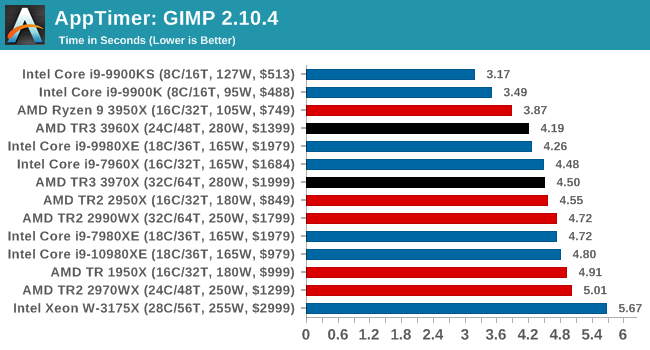
Onto our single threaded tests, and the mainstream hardware with high single thread frequencies wins here, but the 3960X is leading the rest of the pack. Intel's 28-core part here sits last, behind even the 1950X.
3D Particle Movement v2.1: Brownian Motion
Our 3DPM test is a custom built benchmark designed to simulate six different particle movement algorithms of points in a 3D space. The algorithms were developed as part of my PhD., and while ultimately perform best on a GPU, provide a good idea on how instruction streams are interpreted by different microarchitectures.
A key part of the algorithms is the random number generation – we use relatively fast generation which ends up implementing dependency chains in the code. The upgrade over the naïve first version of this code solved for false sharing in the caches, a major bottleneck. We are also looking at AVX2 and AVX512 versions of this benchmark for future reviews.
For this test, we run a stock particle set over the six algorithms for 20 seconds apiece, with 10 second pauses, and report the total rate of particle movement, in millions of operations (movements) per second. We have a non-AVX version and an AVX version, with the latter implementing AVX512 and AVX2 where possible.
3DPM v2.1 can be downloaded from our server: 3DPMv2.1.rar (13.0 MB)
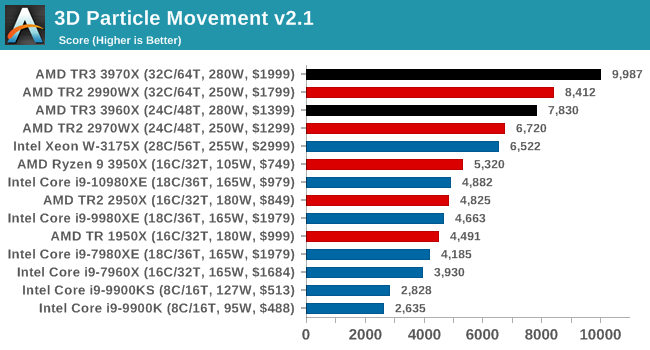
With non-AVX, AMD's floating point units put on a great performance.

This is a workload that can be AVX512 accelerated, and this is the main instance where we can see Intel's CPUs having an advantage.
Dolphin 5.0: Console Emulation
One of the popular requested tests in our suite is to do with console emulation. Being able to pick up a game from an older system and run it as expected depends on the overhead of the emulator: it takes a significantly more powerful x86 system to be able to accurately emulate an older non-x86 console, especially if code for that console was made to abuse certain physical bugs in the hardware.
For our test, we use the popular Dolphin emulation software, and run a compute project through it to determine how close to a standard console system our processors can emulate. In this test, a Nintendo Wii would take around 1050 seconds.
The latest version of Dolphin can be downloaded from https://dolphin-emu.org/
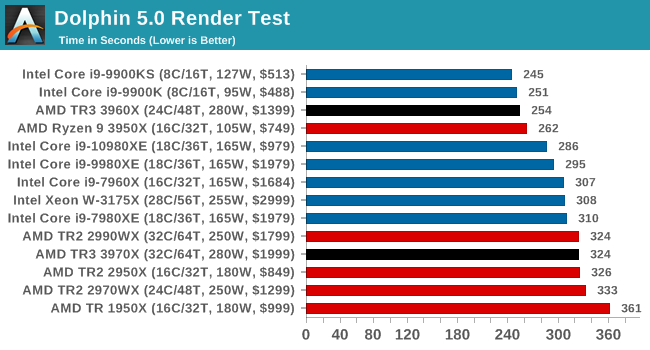
On the single threaded workloads again, and the high frequency mainstream CPUs win here. Interestingly, the 3960X also puts on a really good show, and actually beats our 3950X. Interesting.
DigiCortex 1.20: Sea Slug Brain Simulation
This benchmark was originally designed for simulation and visualization of neuron and synapse activity, as is commonly found in the brain. The software comes with a variety of benchmark modes, and we take the small benchmark which runs a 32k neuron / 1.8B synapse simulation, equivalent to a Sea Slug.
Example of a 2.1B neuron simulation
We report the results as the ability to simulate the data as a fraction of real-time, so anything above a ‘one’ is suitable for real-time work. Out of the two modes, a ‘non-firing’ mode which is DRAM heavy and a ‘firing’ mode which has CPU work, we choose the latter. Despite this, the benchmark is still affected by DRAM speed a fair amount.
DigiCortex can be downloaded from http://www.digicortex.net/
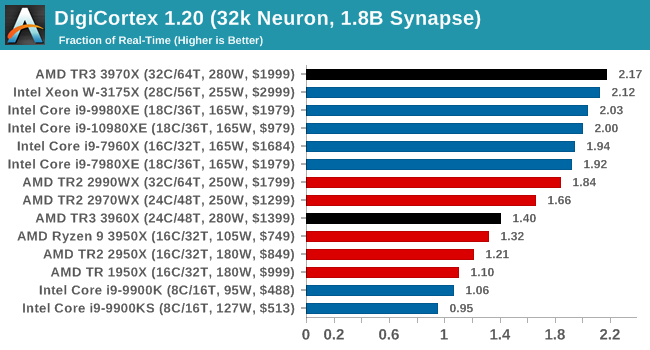
I'm surprised there's that much difference between the 3970X and 3960X here, especially with the 3960X sitting behind the TR2 processors. Might have to re-run this one to double check. But the 3970X puts out a commanding lead.
y-Cruncher v0.7.6: Microarchitecture Optimized Compute
I’ve known about y-Cruncher for a while, as a tool to help compute various mathematical constants, but it wasn’t until I began talking with its developer, Alex Yee, a researcher from NWU and now software optimization developer, that I realized that he has optimized the software like crazy to get the best performance. Naturally, any simulation that can take 20+ days can benefit from a 1% performance increase! Alex started y-cruncher as a high-school project, but it is now at a state where Alex is keeping it up to date to take advantage of the latest instruction sets before they are even made available in hardware.
For our test we run y-cruncher v0.7.6 through all the different optimized variants of the binary, single threaded and multi-threaded, including the AVX-512 optimized binaries. The test is to calculate 250m digits of Pi, and we use the single threaded and multi-threaded versions of this test.
Users can download y-cruncher from Alex’s website: http://www.numberworld.org/y-cruncher/
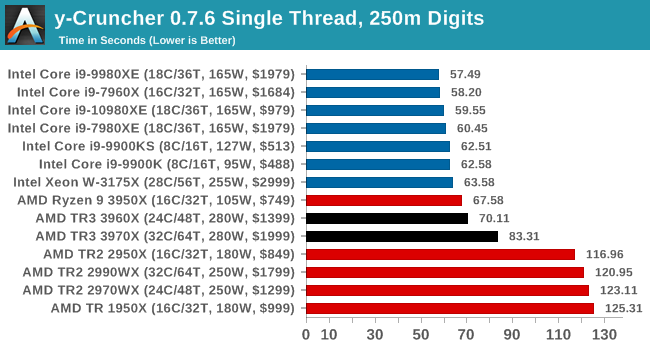
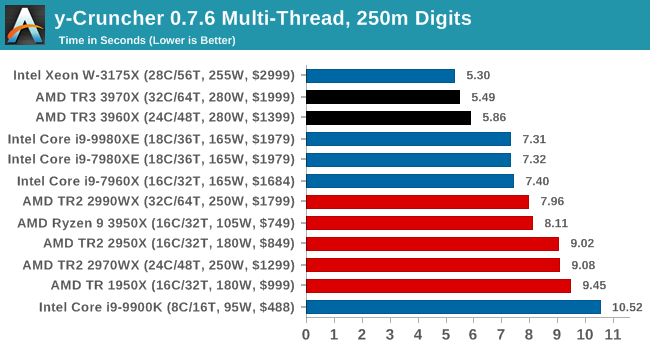
y-Cruncher is also AVX-512 accelerated, however when all the 32 threads come together in MT mode on AVX2, having that many pushes through 18 cores with AVX-512.
Agisoft Photoscan 1.3.3: 2D Image to 3D Model Conversion
One of the ISVs that we have worked with for a number of years is Agisoft, who develop software called PhotoScan that transforms a number of 2D images into a 3D model. This is an important tool in model development and archiving, and relies on a number of single threaded and multi-threaded algorithms to go from one side of the computation to the other.
In our test, we take v1.3.3 of the software with a good sized data set of 84 x 18 megapixel photos and push it through a reasonably fast variant of the algorithms, but is still more stringent than our 2017 test. We report the total time to complete the process.
Agisoft’s Photoscan website can be found here: http://www.agisoft.com/

New records for Photoscan as well.












245 Comments
View All Comments
Fulljack - Wednesday, November 27, 2019 - link
well, even 64eu gen11 graphics actually couldn't even surpass vega 10 on 3700u.YazX_ - Monday, November 25, 2019 - link
@melgross, LOL cool story, your butthurt is so obvious, being a fanboy is something but living in denial is something else.the only reason one would post such comment is to be an Intel employee, heck, even Intel employees are admitting their defeat.
JKflipflop98 - Wednesday, November 27, 2019 - link
No, we're not.mickrussom - Tuesday, December 3, 2019 - link
If you really are an Intel employee- shame!, shame!, shame! - especially if you had anything to do with:Spectre 1/2, Meltdown 3/3a, Speculative Store Bypass, Foreshadow, L1TF, Fallout/MSBDS, ZombieLoad/MFBDS, RIDL MLPDS/MDSUM
It is utterly criminal what Intel has done. I have zero respect for Intel and it is only by the grace of the US Government Intel is allowed to live. What is happening to Boeing should be happening to Intel for the criminally negligent brain damaged cheating lying trash-chips they have produced with these horrific faults for over a decade. This is far worse than FDIV. And I got a new CPU for FDIV. This is a crime wave and Intel has received a pardon and all of us are left with broken chips that when patch by the OS run half speed or worse.
So to all Intel employees, you better hold your heads down in utter shame until the next wave of CPUs comes out. And support ECC on all the chips - its criminally negligent to hold people hostage with RAM errors.
WaltC - Monday, November 25, 2019 - link
You don't really understand how the quarterly bookkeeping works, I can see. Intel's last quarter was already set in their ordering channels long before AMD's July launch of Epyc Zen 2, R3k, and TR3k is only now launching--it will be all of 2020 that you will see Intel's P&L's grow progressively leaner as you see AMD's grow progressively fatter. Generally it takes 2-3 quarters of progressively worse business before a company's woes begin to show up dramatically on the balance sheet, due to good will and other bookkeeping dodges. Next year will be a Halcyon year for AMD and a critical year for Intel no question about it. Already their roles have reversed, with Intel becoming the "value proposition"--but only provided Intel keeps on cutting its prices. What we've also seen predicted many times in the past is that AMD was *doomed*...;) Not..quite..;)Jimbo Jones - Monday, November 25, 2019 - link
@melgrose"Intel had its best year yet" ... more 10nm delays, so called "14nm shortages", no 10nm for desktop yet, nothing for server yet, same rehashed 14nm with the 10980XE bringing almost no improvement at all per core meanwhile in one generation Threadripper beings up to 32% improvement in multi, 20% in single thread, with no answer from Intel to any of these processors at all and their flagship 18 core HEDT being almost equal to Ryzen desktop in heavy workloads.
But that's ok, let's look ahead to 2020 ... Comet lake aims at add two cores and add 100mhz ... I guess that's pretty good ... for Intel ... ;-)
What IS impressive though, is Intel's ability to keep squeezing money out of gullible people willing to keep paying more money for less product -- I guess that's how they managed to make so much money last year?
mickrussom - Tuesday, December 3, 2019 - link
yeah, how quickly they forget Spectre 1/2, Meltdown 3/3a, Speculative Store Bypass, Foreshadow, L1TF, Fallout/MSBDS, ZombieLoad/MFBDS, RIDL MLPDS/MDSUM. they took our money and unlike Boeing they go no flak from FEDGOV for it. and then they act like arrogant rotten gordon gecko types while laughing to the bank while the CPUs still coming are patch against those flaws mostly in microcode and OS kernels STILL!maxxbot - Tuesday, November 26, 2019 - link
AMD didn't have these sorts of products in the past, trying to extrapolate past performance into the future is a fool's errand. Intel was the process champ for decades and guess what? It all changed overnightTargon - Tuesday, November 26, 2019 - link
Financials vs. products. Intel financials were up because many people were upgrading from older dual or quad core products, and OEMs are barely starting to offer third generation Ryzen based machines. For your typical consumer, not the gamers who can afford a $500 9900k, but your typical consumer, would you suggest Intel or AMD based products at this point? Intel has the 9600, 9700, and 9900 as good products, the rest are beaten by AMD products at the same price point.arcamdomain - Tuesday, December 17, 2019 - link
Nokia said the same thing about the phone market.